INDIA
Economy

Economy
Cities in INDIA
| Bangalore | Mumbai |
Popular destinations INDIA
| Goa |
Economy
General
Since independence in 1947, the government has been trying to develop certain sectors of the economy through five-year plans. The nationalized sector plays an important role and a lot of money is invested in this by the government. However, there is no tight schedule and the government's share of the national economy has fallen sharply in certain periods.
The import subsidy, followed as a development strategy since independence, gave way to liberalization in the mid-1980s. According to the seventh five-year plan, the share of the public sector will decrease by 5% compared to the sixth five-year plan.
In the 1980s there was a gradual growth of per capita income (1980-1995 an increase of 3%). In 1994, the national per capita income was $ 310. Inflation remained high during that period (almost 10% in 1985-1995), but could be reduced to 5.4% in 2002.
Although real economic growth rose to more than 10% in 1988-1989, it was only 4.5% in 1995-1996 and 4.3% in 2002, a sign of the instability of the Indian economy. Yet with these growth rates, India is one of the fastest growing economies in the world. In the 21st century, India is experiencing an economic growth spurt. The growth percentages are high, although this seems to have weakened somewhat in recent years. The percentages for 2011,2012 and 2013 are successively 6.3%, 3.2% and 3.8%. After that, the percentage climbed back to 6.7% in 2017. GDP per capita was $ 7,200 in 2017.
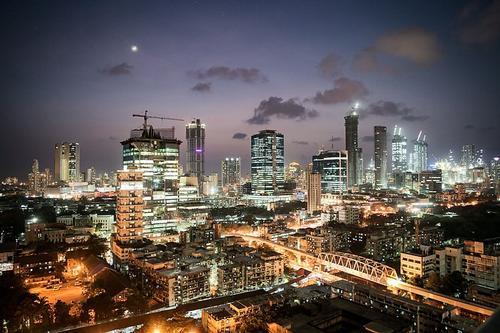 Mumbai Financial and industrial center IndiaPhoto: Ville Hyvönen CC 2.0 Generic no changes made
Mumbai Financial and industrial center IndiaPhoto: Ville Hyvönen CC 2.0 Generic no changes made
Reliable figures on unemployment cannot actually be obtained. It is estimated that around a third of the workforce is wholly or partially unemployed (officially 8.5% in 2017). The unemployment problem seems to be on the increase due to the high annual increase in the workforce of millions at a time.
The Indian economy is very diverse, with many regional and structural differences. On the one hand, India is one of the ten most industrialized countries in the world, with a high technological level in areas such as space travel, nuclear energy and satellite communications. On the other hand, a large part of the population still depends on often small-scale agriculture. The area around Mumbai has been an important industrial and commercial center for decades.
A kind of Indian "Silicon Valley" has developed around Bangalore. Many economic activities also take place around the cities of New Delhi and Madras. Poor states are Bihar, Madhya Pradesh and parts of East and Northeast India.
Important for the economic development of India is also the ever-increasing decentralization of the federal government to the federal states, which are also given more and more space to profile themselves. States such as Andhra Pradesh, Maharashtra and Gujarat know how to interest international business.
Agricultural sector
India is still mainly an agricultural country, of which about 75% of the population lives in the countryside. The agricultural sector employs 47% of the labor force and contributes approximately 15.4% to gross national income (2017). Agricultural production today is mainly aimed at the domestic market. More than 80% of the agricultural area is used for the cultivation of food grains such as wheat and rice. India has two harvest seasons: the kharif, after the wet, hot summer (mainly rice, cotton and millet varieties), and the rabi, after the cool winter (mainly wheat, beans and potatoes).
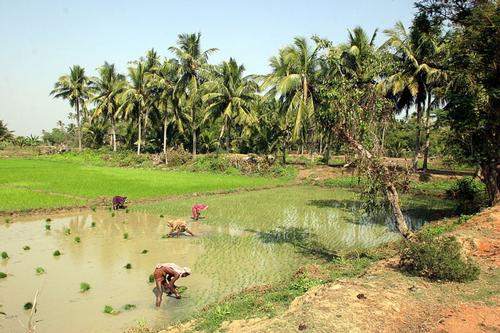 Ricefields IndiaPhoto: Tierecke CC 2.5 Generic no changes made
Ricefields IndiaPhoto: Tierecke CC 2.5 Generic no changes made
Rice cultivation is characteristic of the wetter part of India: Assam, Orissa, Andhra Pradesh and Kerala, among others; wheat is main crop in the Punjab and in Haryana, millet on the Deccan. The main (export) commercial crops are cotton, jute and tea. Coffee, sugar, spices, nuts, tobacco and rubber are mainly crops for the domestic market.
The livestock has a low economic return, partly due to the religious custom of respecting the cow. There is hardly any systematic livestock farming: cattle are mainly used as draft animal and beast of burden. Dairy farming is only encouraged in the Punjab.
The agricultural businesses are generally small, especially in East India (Bihar); in the Punjab, the richest agricultural area in India, there are mainly (medium) large modernized companies; very large, extensive companies only occur in the drier, less fertile areas of Central India.Bosbouw en visserij
Approx. 20% of India's territory is covered by forest and about half of that is exploited. Sandalwood and teak are the main products. The government is trying to combat reforestation projects, not only due to excessive logging, in particular also due to erosion and salinisation of the soil.
India has claimed a 200-mile zone as territorial waters since 1977. About 80% of the fishing takes place along the west coast and there is freshwater fishing in Assam and South Maharashtra.
Mining and energy supply
India has important mineral resources, especially in the states of Bihar and Orissa. The iron ore reserves (± 20 billion tons) that are present there are among the largest in the world. Moreover, a lot of coal, manganese, limestone, dolomite, magnesite, apatite, phosphorite, mica, copper (± 422 million tons) and other ores are also found here. Manganese and iron ore are also mined in Madhya Pradesh, Andhra Pradesh and Tamil Nadu; Karnataka owns gold mines and Kerala bauxite (± 2.7 billion tons) and uranium.
Petroleum is found in the northeast and west; Some of the necessary oil needs to be imported, but India hopes to be self-sufficient in the future. Private sector participation in mining is increasing, and interest in gold and diamond mines is attracting interest from abroad.
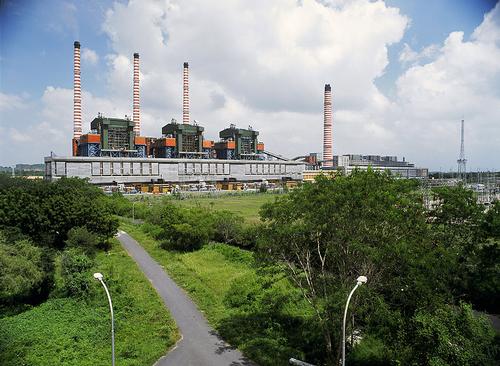 Thermal Power Station IndiaPhoto: Getsuhas08 CC 3.0 Unported no changes made
Thermal Power Station IndiaPhoto: Getsuhas08 CC 3.0 Unported no changes made
The energy supply remains one of the major challenges for India: in particular rural electrification is far from complete. Coal is the main source of energy and reserves are estimated to be around 200 billion tons. The hydropower plants are of less importance due to the large differences in the amount of rainfall per period. The largest hydroelectric power station is the Nagarjunasagardam (1,450 m long) in the Krishna River near the village of Nandikonda in the state of Andhra Pradesh.
In the field of nuclear energy, India has, technologically speaking, a high degree of independence, which stems from the fact that when India was able to manufacture nuclear bombs of its own, Western countries refrained from further cooperation in this field. After that India succeeded in developing a complete fuel cycle by building a reprocessing plant and a fast breeder reactor.
Industry in general
Industry's share of gross national product was 23% in 2017. The largest industrial area is located around Mumbai and Poona, with the cotton industry being the most prominent industry, as well as the chemical, petrochemical, electrical, automotive and plastic industries. Poona owns machine factories and Ahmedabad (Gujarat) textile industry; smaller centers in this area are Surat (cotton) and Baroda (petrochemical).
The second industrial area includes Calcutta and environs and the Bihar-Orissa-Madhya Pradesh border area along the Damodar River. The jute industry, as well as the metal processing industry, the paper industry, the chemical and pharmaceutical industry, dominate in Calcutta. The Damodar area is the center of mining and heavy industry.
A third important area is the south, with centers such as Bangalore, Coimbatore and Madras, including electrical engineering, aircraft construction, the steel industry, textiles, oil refineries and the leather industry.
There are also several large industrial cities across the country such as Vishakapatnam with shipbuilding, Hyderabad with machine factories, Benares with textile and locomotives, Bhopal with electrical engineering and chemical industry, Kanpur with leather and textile and in the Punjab Ludhiana, Jullundur and Amritsar with bicycles, sports equipment and textiles.
The film industry is also important; India is one of the largest film producers in the world and the main ones are Mumbai (Bollywood) Malayalam and Calcutta.
chemical and plastics industry
The market size for chemical products is large, with the main market segments being petrochemical intermediates (including ethylene, xylene, benzene, methanol, phenol), fertilizers (including urea and diammonium phosphate), industrial chemicals (including pigments, pharmaceuticals, lubricants, synthetic resin). Color - and dyes and agrochemicals.
Clothing and textile industry
The textile industry is the largest employer in India, as it employs approximately 120 million people. This very important economic sector provides almost 14% of total industrial production, 4% of GDP and more than a third of export earnings.
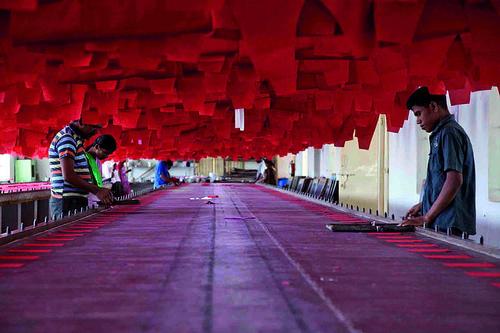 Textile Workers IndiaPhoto: Fabrics for fredom CC 2.0 Generic no changes
Textile Workers IndiaPhoto: Fabrics for fredom CC 2.0 Generic no changes
The Indian textile sector is strongly export oriented, approximately one third of the total production is destined for export. The government's goal is to create the conditions for an increase in India's textile and apparel exports to the tune of $ 50 billion. An important part of achieving this endeavor is to encourage foreign investment.
Machine industry and metal industry.
The main market segments are industrial installations and so-called process machinery machine tools, earthmoving and construction machines.
The main product groups are turbines, cement machines, boilers, chemical plants, electric generators and textile machines. The Indian government is still prominent in this sector.
The main suppliers of capital goods are Germany, the United States, Japan and Italy.
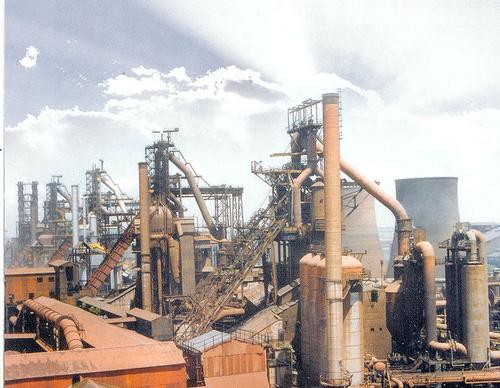 Steel Industry IndiaPhoto: P.K Niyogi CC 3.0 Unported no changes made
Steel Industry IndiaPhoto: P.K Niyogi CC 3.0 Unported no changes made
The steel industry is concentrated in six large steel mills and approximately 180 smaller factories. Five of the major steel mills are state owned, all smaller steel mills are privately owned.
Transport equipment industry
In 1980, car production was opened up to foreign investment. Production subsequently increased enormously and at the moment about 600,000 cars and trucks are made per year. Competition in the small car market is fierce, with Maruti leading the market with approximately 335,000 units. A number of major international car manufacturers have entered into joint ventures.
India also manufactures the largest number of bicycles, mopeds, motorcycles and scooters in the world.
Trade
India imports machinery, iron, steel, petroleum products (accounting for 27.2% of total imports), cotton, chemicals, fertilizers, food grains and rice. Main suppliers are China, United Arab Emirates, United States, Switzerland and Saudi Arabia.
The main export items are precious stones, crafts, jewelery, textiles, cotton, jute, tea, iron ore, hides and skins for the leather industry, fresh fruits, nuts and sugar.
A relatively new, rapidly growing category of export items is the engineering products: railway wagons, refrigerators, electric cables and pipelines, diesel engines and cars, but exports declined in the early 1980s as a result of the recession in the developed countries. The main customers are the United States, China, Hong Kong, the United Arab Emirates and Singapore.
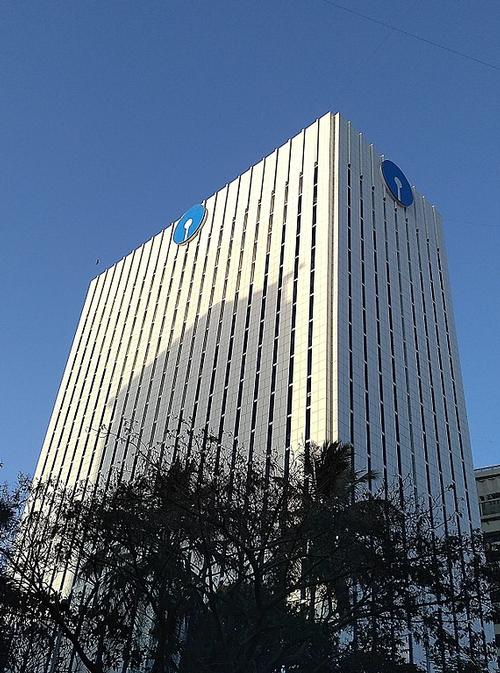 Bank of IndiaPhoto: Digamber in the public domain
Bank of IndiaPhoto: Digamber in the public domain
Indian traders and entrepreneurs play a prominent role in Asia (Middle East, Southeast Asia); In addition, many Indians work as guest workers in the countries around the Persian Gulf and their earnings are a very important currency source for the country.
The trade balance has been almost always negative since the 1980s. In 2017, $ 452.2 billion was imported and $ 304.1 billion was exported.
Transport
The inadequate infrastructure is one of the major obstacles to India's economic development. The countryside in particular is not or hardly accessible by train or car. Railways, shipping and aviation are more important to the national economy than the road network, which has not yet been sufficiently developed.
In 2003, the road network was approximately 3 million km long, about half of which was paved. National highways cover approximately 58,000 kilometers, but this is only 2% of the total road network. The quality of the highways is generally not good due to poor maintenance. Nearly two thirds of the national trunk road network was single lane. In the past ten years, 13,000 kilometers of highways have been provided with more lanes.
The state's electrified rail network is the longest in Asia and the third longest in the world, at nearly 62,500 km. The railways are wholly state-owned and employ approximately 1.5 million workers.
As a shipping nation, India ranks high in the world in terms of tonnage. It has the largest merchant fleet among the former developing countries. Compared to ports in other parts of Asia, labor productivity is low and investment in ports is inadequate. This means that the average duration remains too long, as well as the waiting time before it can be moored.
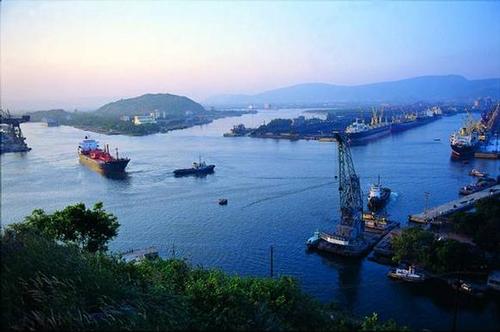 Port Vigaz IndiaPhoto: Nballa at the English language Wikipedia CC 3.0 Unported no changes made
Port Vigaz IndiaPhoto: Nballa at the English language Wikipedia CC 3.0 Unported no changes made
India has 12 major ports, all run by the Port Trust of India, and approximately 150 smaller ports are run by state governments. Important ports on the west coast are Mumbai, Kandla, Nhava Sheva, Marmagao, Cochin and Mangalore. On the east coast are the major ports of Kolkata-Haldia, Chennai, Paradip, Tuticorin and Visakhapatnam.
The inland waterways have a total length of 13,500 kilometers, a fifth of which is easily navigable for larger ships. This type of transport mainly takes place in the states of Tamil Nadu, Bihar, Orissa, West Bengal and Kerala.
Air transport is provided by the state-owned companies Air India (foreign flights) and Indian Airlines (domestic and neighboring countries in South Asia).
India has six international airports and several hundred other airports. Fewer than 100 airports are operational. The main airports are Palam (New Delhi), Santa Cruz (Mumbai), Dum-Dum (Kolkata) and Meenambakkam (Madras). The newly built Bangalore International Airport is the first Indian airport to become privately owned.
More than half of the total air traffic passes through the airports of Mumbai and New Delhi. Air traffic has grown by more than 125% in the past decade.
Sources
Boon, H. / India : mensen, politiek, economie, cultuur
Koninklijk Instituut voor de Tropen/Novib
Caldwell, J.C. / India
Chelsea House
Chatterjee, M. / India
Dorling Kindersley
Dunlop, F. / India
Van Reemst
Nicholson, L. / India
Kosmos-Z&K
Peterse, L. / India
Gottmer/Becht
Srinivasan, T. / India
Times Books
Te gast in India
Informatie Verre reizen
CIA - World Factbook
BBC - Country Profiles
Last updated December 2025Copyright: Team The World of Info